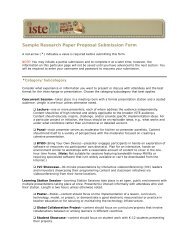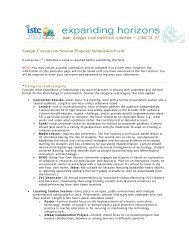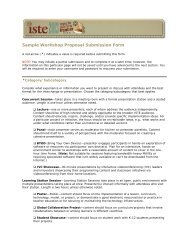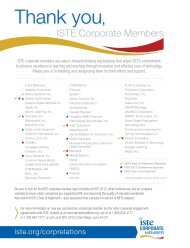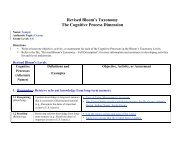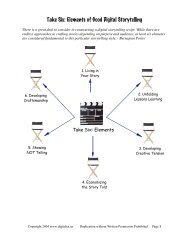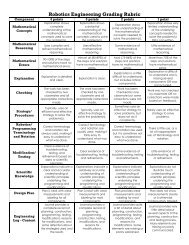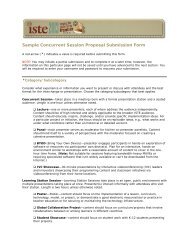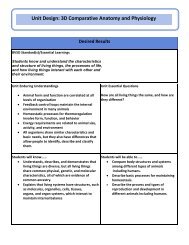- Page 1 and 2: IMPACTFUL STUDENT LEARNING OUTCOMES
- Page 3 and 4: Dedicated to my wife, Lisa.Your unw
- Page 5 and 6: IMPACTFUL STUDENT LEARNING OUTCOMES
- Page 7 and 8: To the research participants, I wan
- Page 9 and 10: Differences Between Group A and Gro
- Page 11 and 12: 17. Summary of findings for Changes
- Page 13 and 14: LIST OF APPENDICESAppendixA. Studen
- Page 15 and 16: 2be effective and sustainable. Howe
- Page 17 and 18: 4the Educational Digital Divide to
- Page 19 and 20: 6to one-to-one student laptop progr
- Page 21 and 22: 8potential in order to seize these
- Page 23 and 24: 10used to benefit and empower parti
- Page 25 and 26: 12While there are several documente
- Page 27 and 28: 14noted as a central factor in the
- Page 29 and 30: 16spreadsheet tools, etc.), (2) ena
- Page 31 and 32: 18Anytime Anywhere Learning project
- Page 33 and 34: 20Educational Digital Divide by ins
- Page 35 and 36: 22Chapter Two: Literature ReviewInt
- Page 37 and 38: 24Educational Digital Divide in U.S
- Page 39 and 40: 26Digital Divide has three levels:
- Page 41 and 42: 28students. As such, the remainder
- Page 43 and 44: 30teachers in low SES classrooms fo
- Page 45: 32linguistic backgrounds, participa
- Page 49 and 50: 36However, if some policy change we
- Page 51 and 52: 38Helping Teachers Progress Through
- Page 53 and 54: 40the project as part of the Teache
- Page 55 and 56: 42Increased teacher workload. In bo
- Page 57 and 58: 44classroom and less ‘disbursers
- Page 59 and 60: 46al., 1998; Russell et al., 2004).
- Page 61 and 62: 48students engaged in collaborative
- Page 63 and 64: 50Researchers showed that students
- Page 65 and 66: 52claimed that along with distracti
- Page 67 and 68: 54non-ACOT classrooms in vocabulary
- Page 69 and 70: 56Insufficient Measure of Student L
- Page 71 and 72: 58one-to-one student laptop program
- Page 73 and 74: 602004, Rockman et al., 2004). Next
- Page 75 and 76: 62Yet one-to-one student laptop pro
- Page 77 and 78: 64laptop programs is insufficient.
- Page 79 and 80: 66Chapter Three: MethodologyIntrodu
- Page 81 and 82: 68primary data source. Teachers and
- Page 83 and 84: 70Research DesignThis study employe
- Page 85 and 86: 72Research SitesThe research sites
- Page 87 and 88: 74Table 3Research sites with school
- Page 89 and 90: 76parents has received a high schoo
- Page 91 and 92: 78the division of socioeconomic sta
- Page 93 and 94: 80pedagogy and curriculum. In 2006,
- Page 95 and 96: 82At each site, two administrators
- Page 97 and 98:
84administrator, I identified and s
- Page 99 and 100:
86As a tool for comparison between
- Page 101 and 102:
88their non-low SES peers. The adde
- Page 103 and 104:
90This breadth of knowledge across
- Page 105 and 106:
92conditions of its students being
- Page 107 and 108:
94Educational Digital Divide and as
- Page 109 and 110:
96Chapter Four: FindingsIntroductio
- Page 111 and 112:
98Access to Computers and the Inter
- Page 113 and 114:
100Table 10Counts and expected coun
- Page 115 and 116:
102Table 11t-test results for class
- Page 117 and 118:
104Table 13t-test results for stude
- Page 119 and 120:
106SummaryThe data showed that Educ
- Page 121 and 122:
108qualitative data are presented i
- Page 123 and 124:
110of teachers, students, and admin
- Page 125 and 126:
112from teachers’ self-assessment
- Page 127 and 128:
114Not surprisingly, improvements i
- Page 129 and 130:
116offered fewer opportunities for
- Page 131 and 132:
118conduct just-in-time research, f
- Page 133 and 134:
120their motivation, engagement, an
- Page 135 and 136:
122gave an example of this type of
- Page 137 and 138:
124Students across the five researc
- Page 139 and 140:
126Participants at Hemings and Ulys
- Page 141 and 142:
128to laptops. A Ulysses High Schoo
- Page 143 and 144:
130Parallel to students’ claims t
- Page 145 and 146:
132culture, teachers said they freq
- Page 147 and 148:
134skills, nor the depth of informa
- Page 149 and 150:
136needed explicit instruction in a
- Page 151 and 152:
138workforce. To land higher paying
- Page 153 and 154:
140because they often failed to dem
- Page 155 and 156:
142communications and to disclose a
- Page 157 and 158:
144Table 18Summary of findings for
- Page 159 and 160:
146exchange information over email
- Page 161 and 162:
148Quantity and QualityAccording to
- Page 163 and 164:
150at a lower quality - being less
- Page 165 and 166:
152and Ulysses High School said the
- Page 167 and 168:
154designed for recreation and soci
- Page 169 and 170:
156Table 19Summary of findings for
- Page 171 and 172:
158were carried in padded bags, sto
- Page 173 and 174:
160Nonetheless, students at all fiv
- Page 175 and 176:
162data within the past month. It s
- Page 177 and 178:
164students developing this discipl
- Page 179 and 180:
166Table 20Summary of findings for
- Page 181 and 182:
168resources for low SES students i
- Page 183 and 184:
170and had developed intrepid attit
- Page 185 and 186:
172laptop to research salary scales
- Page 187 and 188:
174Across the academic areas - scho
- Page 189 and 190:
176Chapter Five: Discussion and Rec
- Page 191 and 192:
178(Clark & Gorski, 2002; Warschaue
- Page 193 and 194:
180Deeper understanding of content.
- Page 195 and 196:
182The increases in constructivist
- Page 197 and 198:
184development of higher order thin
- Page 199 and 200:
186and teachers’ claims that the
- Page 201 and 202:
188these activities were described
- Page 203 and 204:
190The findings for both this study
- Page 205 and 206:
192programs had long-term impacts o
- Page 207 and 208:
194research showed that students ex
- Page 209 and 210:
196maintain a possession with high
- Page 211 and 212:
198academic student learning outcom
- Page 213 and 214:
200impacts on students’ academic
- Page 215 and 216:
202First, the dearth of available r
- Page 217 and 218:
204This finding has implications at
- Page 219 and 220:
206which addresses the first level
- Page 221 and 222:
208programs within their schools to
- Page 223 and 224:
210In order for this research to im
- Page 225 and 226:
212programs in low SES schools are
- Page 227 and 228:
214which would make program sustain
- Page 229 and 230:
216Brooks, J.G., & Brooks, M.G. (19
- Page 231 and 232:
218Dwyer, D. C., Ringstaff, C., & S
- Page 233 and 234:
220Lowther, D. L., Moss, S. M., & M
- Page 235 and 236:
222Notebooks for Schools by Toshiba
- Page 237 and 238:
224Tan, C. L., & Morris, J. S. (200
- Page 239 and 240:
Appendices226
- Page 241 and 242:
228Explanation of Survey QuestionsT
- Page 243 and 244:
230Question 6. This question was de
- Page 245 and 246:
232Appendix B: Group A Administrato
- Page 247 and 248:
234Explanation of Interview Questio
- Page 249 and 250:
236Appendix C: Group B Administrato
- Page 251 and 252:
238Explanation of Interview Questio
- Page 253 and 254:
240Appendix D: Student Focus Group
- Page 255 and 256:
242Appendix E: Group A Teacher Focu
- Page 257 and 258:
244Explanation of Focus Group Quest
- Page 259 and 260:
246Appendix F: Group B Teacher Focu
- Page 261 and 262:
248Explanation of Focus Group Quest





